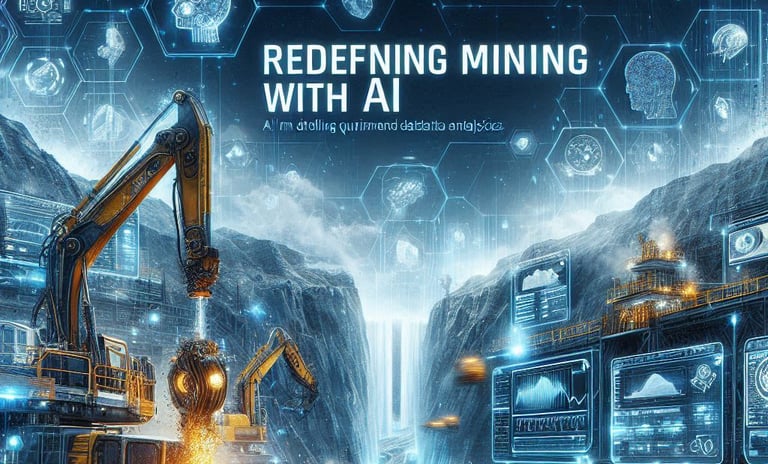The AI Revolution in Mineral Exploration: Transforming How We Discover Resources
Xuan-Ce Wang
5/26/20254 min read


In an era where demand for critical minerals continues to rise while easily accessible deposits become increasingly scarce, artificial intelligence is emerging as a game-changing technology in the mineral exploration industry. As we face unprecedented challenges in finding the resources needed for our clean energy transition, AI offers promising solutions that are reshaping how we discover, evaluate, and develop mineral deposits.
The Growing Challenge of Modern Mineral Exploration
The minerals industry stands at a critical crossroads. Over the last two decades, discovery costs have skyrocketed by 400%, while success rates have declined by 30%. Traditional exploration methods that served us well in the past are yielding diminishing returns as surface-level deposits have largely been discovered, forcing us to look deeper and in more complex geological settings.
This challenge comes at a time when global demand for critical minerals is projected to increase dramatically. Copper demand alone is expected to rise by 50% by 2040, according to the International Energy Agency, driven primarily by renewable energy technologies and electric vehicles.
How AI Changes the Exploration Paradigm
Artificial intelligence represents a fundamental shift in approach compared to conventional exploration methods. While traditional geostatistical techniques like kriging and inverse distance weighting rely on predefined geological assumptions, AI works directly with raw exploration data to discover patterns and relationships that might otherwise remain hidden.
AI doesn't rely on predefined geological assumptions but instead discovers patterns directly from data, similar to how image recognition works. This ability to identify complex, non-linear relationships between multiple variables allows AI systems to uncover insights that even experienced human geologists might miss.
The Jundy Mine Success Story
The effectiveness of AI in mineral exploration is perhaps best illustrated by the Jundy Mine case study. This challenging orogenic gold deposit featured a 40% nugget factor, meaning nearly half of the gold distribution was randomly scattered throughout the deposit—a nightmare scenario for traditional exploration methods.
When AI was implemented at the site, it delivered remarkable results:
24% improvement in efficiency for locating high-grade blocks
Discovery of 3.2 times more high-grade material using the same number of drill holes
Identification of zones where grade exceeded 4.5 g/ton (more than double the economic cutoff of 2.2 g/ton)
Approximately $18 million in additional recovered value
As mining engineer Robert Thompson noted, "What's particularly impressive is that we achieved a higher hit rate precision without sacrificing exploration coverage."
Key AI Techniques Driving Success
Several innovative AI approaches are proving particularly valuable in mineral exploration:
1. Advanced Geochemical Analysis
AI excels at identifying complex geochemical signatures that serve as pathfinders to mineralization. Unlike conventional approaches that might focus on a handful of indicator elements, AI can analyze relationships between dozens of elements simultaneously, using various correlation statistics to capture different types of relationships.
This comprehensive analysis can identify both positive indicators (like arsenic correlating with gold) and negative indicators (such as high vanadium suggesting an absence of gold mineralization).
2. Data-Driven Lithological Classifications
AI transforms interpretive lithologies into data-driven inputs, creating consistent classifications based on measurable parameters rather than relying solely on geologist interpretations. This approach has revealed that minor geological features, such as lamprophyre dykes, can be critical pathfinders for gold mineralization, likely indicating deep-tapping structures that facilitate hydrothermal fluid movement.
3. Ensemble Modeling for Risk Assessment
By training multiple models with varying input combinations, AI creates ensemble models that generate probability volumes quantifying the likelihood of mineralization. This allows exploration teams to make risk-weighted decisions, targeting areas with:
Prediction probabilities above 10% for early-stage exploration
Prediction probabilities above 50% for development drilling
Research from SLR Consulting suggests this approach can reduce exploration costs by up to 35% while simultaneously improving discovery rates.
4. Innovative Data Processing
Techniques like advanced compositing retain maximum grade information by using both average and maximum composites as separate inputs. This approach captures high-grade nugget values that might be lost in traditional methods.
At one West African gold deposit, this technique identified high-grade shoots that added 15% to the deposit's recoverable gold.
Applications Across Different Deposit Types
AI's applicability extends across various deposit types, each with its unique challenges:
For iron oxide copper-gold (IOCG) deposits, AI has proven effective in identifying complex alteration patterns and structural controls. A case study from a Chilean copper asset with over 120,000 geochemical samples showed AI discovered resources with in-situ value exceeding $64 million, featuring average grades three times above the economic cutoff.
As Dr. Carlos Mendez, a structural geologist, observed: "The AI identified structural controls completely missed by conventional interpretation."
Even in data-sparse environments, AI can prioritize available inputs to extract valuable insights. In one case, it identified significant potential in material logged as country rock, with subsequent assaying revealing low-grade copper mineralization in approximately 40% of cases.
Economic Benefits and Risk Reduction
Beyond improving discovery rates, AI offers substantial economic benefits by reducing financial risks associated with critical mineral projects. A 2024 study in Nature Communications introduced the concept of a "back-ended risk premium"—an additional risk for investors in projects with unaddressed barriers.
AI can mitigate this risk by:
Shortening project durations
Improving prediction accuracy
Making investments more attractive
These benefits align with AI's potential to reduce exploration costs by up to 35% while improving discovery rates, as noted in industry research.
Recent Developments and Ongoing Challenges
As of 2025, recent developments in AI for mineral exploration include:
Big data analytics handling growing multi-modal datasets
Companies like Earth AI focusing on greenfield exploration for clean energy minerals
Partnerships such as Barrick Gold with Fleet Space Technologies leveraging satellite technology and AI to enhance efficiency
However, challenges persist, particularly in ensuring data quality in greenfield areas where low-quality data and inconsistent sampling can limit success. A 2024 review highlighted the need for innovative methodologies to address these issues as the industry transitions into the big data era.
Conclusion: The Future of Mineral Exploration
AI is transforming mineral exploration, offering unprecedented opportunities to discover new deposits more efficiently and accurately. By enhancing data analysis, optimizing exploration strategies, and reducing costs and risks, AI is poised to meet the growing demand for critical minerals essential for our clean energy future.
As traditional methods become less effective for finding deeper, harder-to-find resources, AI represents not just an incremental improvement but a fundamental shift in how we approach mineral exploration. With continued innovation and collaboration between data scientists and geologists, the full potential of AI in mineral exploration is just beginning to be realized.
The minerals industry stands at the dawn of a new era—one where data-driven approaches and machine learning algorithms work alongside human expertise to ensure we can meet the growing global demand for the materials that will build our sustainable future.








